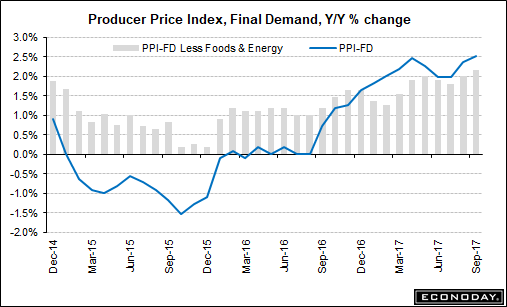Inflation holds the key for Wall Street
As stocks continue to ascend to new record highs amid a streak of low volatility and extreme valuations, an equilibrium has set in on Wall Street. Asset prices are lofty because interest rates remain low. In fact, broadly measured financial conditions have actually become easier over the last few years despite the Federal Reserve's efforts to tighten monetary policy.
And even with unimpressive GDP growth rates and intense labor market tightening, this dynamic looks set to continue as long as inflation remains low. This is the hinge on which all else depends.
Should inflation accelerate -- most likely via "cost-push" pressures, in which businesses try to pass higher labor expenses on to consumers -- the Fed would be forced to accelerate its rate hike schedule. That would risk bond market turmoil, which would then spill into all other asset classes, including stocks.
So then, what's keeping inflation at bay? Or at least near the Fed's 2 percent target? Fed Chair Janet Yellen isn't sure. She told an international banking seminar on Sunday that the persistence of subdued inflation has been a surprise this year, though she still believes prices will soon pick up.
According to Capital Economics, the answer is the ongoing influence of temporary, short-lived factors. Things like the severe price competition among wireless carriers as the smartphone market grows more saturated and established players like AT&T (T) and Verizon (VZ) are forced to compete on price to fend off plucky contenders like T-Mobile (TMUS).
The result was that the consumer price index subcomponent for phone services was falling at a 9 percent annual rate as recently as August.
Over the past few months, prices of goods have lagged behind, down 1 percent from last year in September. That's the weakest result since 2004. New-vehicle prices were a particular soft spot as dealers offered aggressive discounts to move an inventory backlog of 2017 models. Even drug prices fell 0.9 percent from last year.
Of course, energy prices have been muted as well, with crude oil stuck in a sideways pattern near the $50-a-barrel threshold since May 2016 and steadfastly refusing to budge. And the rise in shelter costs has slowed slightly since peaking at a 3.6 percent annual rate last December.
But change is coming.
Flood damage from hurricanes is boosting auto demand and taking wrecked vehicles off the market, tightening supply. Moreover, the roughly 10 percent decline in the U.S. dollar from its springtime levels should soon translate into higher import prices, which will percolate throughout the supply chain and eventually result in higher prices for consumers.
Indeed, producer price inflation has jumped back above the 3 percent annual rate, looking ready to zoom back to highs not seen since 2011 and 2012 (chart above). If so, Wall Street will be forced to modify its relaxed estimate of the pace of Fed interest rate hikes in the coming years. That should cause consternation for the stock market's bulls.





